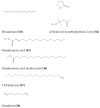Traditional Uses, Pharmacological Activities, and Phytochemical Analysis of Diospyros mespiliformis Hochst. ex. A. DC (Ebenaceae): A Review
- PMID: 38067488
- PMCID: PMC10708241
- DOI: 10.3390/molecules28237759
Traditional Uses, Pharmacological Activities, and Phytochemical Analysis of Diospyros mespiliformis Hochst. ex. A. DC (Ebenaceae): A Review
Abstract
Diospyros mespiliformis Hochst. ex. A. DC is widely distributed throughout Africa and around the world. It is utilized ethnobotanically to treat fevers, wounds, malaria, diabetes mellitus, and other diseases. This review aims to provide an exhaustive overview of the traditional uses, pharmacology, and phytochemical analysis of D. mespiliformis, with the objective of identifying its therapeutic potential for further research. Scientific resources, including Google Scholar, Science Direct, Web of Science, Pub Med, and Scopus, were used to find pertinent data on D. mespiliformis. Secondary metabolites tentatively identified from this species were primarily terpenoids, naphthoquinones, phenolics, and coumarins. D. mespiliformis has been reported to demonstrate pharmacological activities, including antimicrobial, antiproliferative, antiparasitic, antioxidant, anti-inflammatory, antiviral, anti-hypersensitivity, and antidiabetic properties. The phytochemicals and extracts from D. mespiliformis have been reported to have some pharmacological effects in in vivo studies and were not toxic to the animal models that were utilized. The D. mespiliformis information reported in this review provides researchers with a comprehensive summary of the current research status of this medicinal plant and a guide for further investigation.
Keywords: Diospyros mespiliformis; pharmacology; phytochemicals; toxicity; traditional uses.
Conflict of interest statement
The authors declare no conflict of interest.
Figures









Similar articles
-
Comparative antimalarial, toxicity and mito-protective effects of Diospyros mespiliformis Hochst. ex A. DC. and Mondia whitei (Hook.f.) Skeels on Plasmodium berghei infection in mice.J Ethnopharmacol. 2021 Mar 25;268:113585. doi: 10.1016/j.jep.2020.113585. Epub 2020 Nov 12. J Ethnopharmacol. 2021. PMID: 33189839
-
A new acylated flavone glycoside, in vitro antioxidant and antimicrobial activities from Saudi Diospyros mespiliformis Hochst. ex A. DC (Ebenaceae) leaves.Z Naturforsch C J Biosci. 2022 Mar 3;77(9-10):387-393. doi: 10.1515/znc-2021-0291. Print 2022 Sep 27. Z Naturforsch C J Biosci. 2022. PMID: 35245970
-
Empirical use, phytochemical, and pharmacological effects in wound healing activities of compounds in Diospyros leaves: A review of traditional medicine for potential new plant-derived drugs.J Ethnopharmacol. 2025 Jan 30;337(Pt 3):118966. doi: 10.1016/j.jep.2024.118966. Epub 2024 Oct 18. J Ethnopharmacol. 2025. PMID: 39427738 Review.
-
Acute and sub-chronic toxicity evaluation of the crude methanolic extract of Diospyros mespiliformis hochst ex a. Dc (ebenaceae) and its fractions.Toxicol Rep. 2020 Sep 1;7:1138-1144. doi: 10.1016/j.toxrep.2020.08.028. eCollection 2020. Toxicol Rep. 2020. PMID: 32983901 Free PMC article.
-
Diospyros, an under-utilized, multi-purpose plant genus: A review.Biomed Pharmacother. 2017 Jul;91:714-730. doi: 10.1016/j.biopha.2017.05.012. Epub 2017 May 9. Biomed Pharmacother. 2017. PMID: 28499243 Review.
Cited by
-
Traditional ecological knowledge and practices in Zimbabwe: medicinal ethnobotany and ethnozoology among communities in Chipinge district.J Ethnobiol Ethnomed. 2025 Aug 14;21(1):55. doi: 10.1186/s13002-025-00809-w. J Ethnobiol Ethnomed. 2025. PMID: 40813672 Free PMC article.
-
Ethnobotanical study of medicinal plants used to treat human and livestock ailments in Addi Arkay district, northwest Ethiopia.J Ethnobiol Ethnomed. 2025 May 9;21(1):31. doi: 10.1186/s13002-025-00775-3. J Ethnobiol Ethnomed. 2025. PMID: 40346565 Free PMC article.
-
Storable, neglected, and underutilized species of Southern Africa for greater agricultural resilience.Plant Environ Interact. 2024 Aug 23;5(4):e70004. doi: 10.1002/pei3.70004. eCollection 2024 Aug. Plant Environ Interact. 2024. PMID: 39183979 Free PMC article. Review.
References
-
- Atta-U-Rahman M., Igbal C., Thomson W.J. Bioassay Techniques for Drug Development. 2nd ed. Taylor and Francis; Singapore: 2005.
-
- Gerard J., Louppe D. Afzelia africana Sm. ex pers. (Internet) Record from PROTA4U. PROTA (Plant Resources of Tropical Africal/Ressources Vegetales de l’Afrique Tropicale); Wageningen, The Netherlands: 2011.
-
- Orwa C., Mutua A., Kindt R., Jamnadass R., Simons A. Agroforestree Database: A Tree Reference and Selection Guide. World Agroforestry Centre; Nairobi, Kenya: 2009. Version 4.
-
- Dangoggo S.M., Hassan L.G., Sadiq I.S., Manga S.B. Phytochemical analysis and antibacterial screening of leaves of Diospyros mespiliformis and Ziziphus spina-christi. J. Chem. Eng. 2012;1:31–37.
-
- Esimone C.O., Nworu C.S., Onuigbo E.B., Omeje J.U., Nsirim K.L., Ogbu J.C., Ngwu M.I., Chah K.F. Anti-mycobacterial activity of root and leaf extracts of Anthocleista djalonensis (Loganiaceae) and Diospyros mespiliformis (Ebenaceae) Int. J. Green Pharm. 2009;3:201–205.
Publication types
MeSH terms
Substances
LinkOut - more resources
Full Text Sources
Molecular Biology Databases

